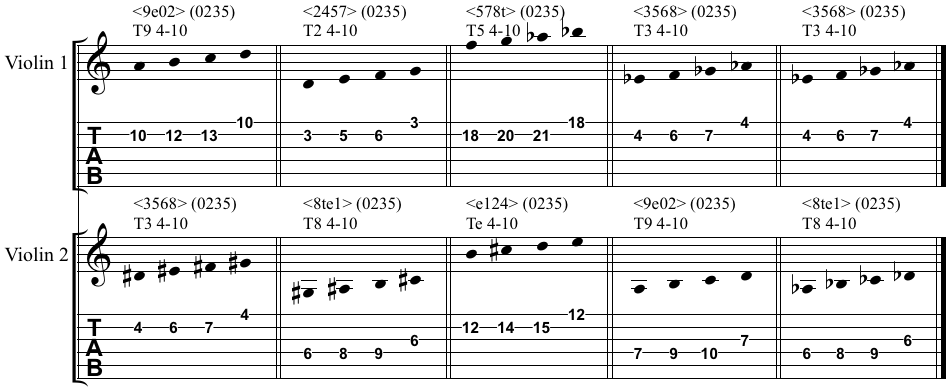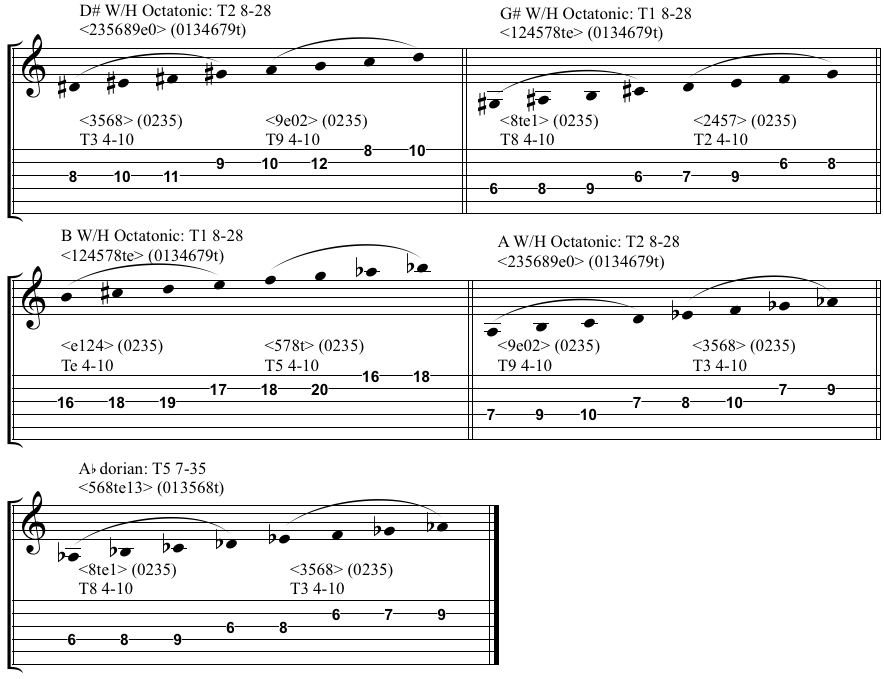Mr. Big Noodles
Theory God
Some set theory to get you thinking. I'll pose a bunch of rhetorical questions and answer them for your benefit.
0. What is a pitch?
A pitch is a note that we can name. These consist of the twelve notes of the chromatic scale and their enharmonic equivalents. A# and B♭are the same sounding pitch, but they may be considered different pitches on a theoretical level depending on their function within a given piece of music.
1. What is a pitch class?
A pitch class (abbreviated "p.c.") is a pitch and all of its enharmonic equivalents, minus the information about function. We use integer notation to represent pitch classes with numbers. We start at C, which is 0, and work our way up the chromatic scale until we hit B, which is 11. B♭/10 and B/11 are two-digit numbers in base 10. It's cleaner to have everything be single digit however, so we use t and e in place of 10 and 11.
We also have [intervals] (and [interval classes]; more later), which are the measure of half steps between p.c.'s. So from 5 to 6 is [1], 5 to 7 is [2], and so on. [These brackets are the notation for anything involving intervals.]
2. What is a set?
A set is a group of pitch classes that have structural significance in a piece of music. Let's assume we are dealing with an A minor pentatonic scale.
{These brackets indicate an unordered set. Unordered sets are the p.c.'s as you would find them in the wild.}
Of course, we know that we can have minor pentatonic scales in many different keys. Here's a B♭ minor pentatonic scale: {t1358} (Notice that I transposed by adding 1 to each integer.)
3. A word about transposition.
In set theory, we may or may not be dealing with music that is in a key. As such, key can become a hindrance to the overall point we make. Instead, we are concerned with the pitch level, or transposition level, at which the set occurs. If a set is based off of p.c. 4, then we would use the shorthand "T4" to indicate that is... based off of p.c. 4. If we were to transpose it up a half step, we would indicate the transposition level as "T5", and so on. We'll come back to this.
4. A word about inversion.
Sets can be flipped upside down to get what we call an "inverted set." Inversion takes the intervals of a set and changes their direction. If you have the two-note set {03}, then you can think of it as 0+3. Inversion would change it to 0-3, which results in the p.c.'s {09}. Huh?! Because this is mod12, 0-1=e, 0-2=t, 0-3=9.
Let's do a big set. Take that A minor pentatonic scale again: {90247}
Here is that set with everything shown as a sum from 9:
To invert it, we would change all the addition to subtraction:
So the inversion of {90247} is {9642e}. (If we are inverting around 9, that is.)
5. What is a set class?
A set class is an abstraction of every single transposition and inversion of a set. Set classes are expressed as a (prime form). Prime forms all start with 0 and are the smallest, most packed rotation of the set. To get to a prime form, we first need to convert a set to <normal order>. Normal order is sort of halfway between an {unordered set} and (prime form). Let's use an easy set:
Steps to getting normal order
Ascending! {236}
Smallest intervals! {23} spans [interval class 1], {36} spans [3]. If we go around from 6 to 2, we get [8], which is a huge interval. It's safe to say that {236} is as small as we can make this thing.
Because {236} is the smallest arrangement of those p.c.'s, we can upgrade its status to that of a normal order. Congratulations, <236>.
Converting <normal order> to (prime form)
We would say that <236> is T2(014). In other words, <236> is (014) transposed up [2].
If we have an inverted set, we need to uninvert it to get normal order.
Getting normal order from inverted sets
5. Success! <236>
Do the prime form!
<236> minus 2 = T2I(014)
Because this was an inverted set, we indicate the transposition as T2I. ("I" means "inverted.")
That's all for now. I'll take questions and hopefully get to interval vectors and Forte codes next time.
Summary of brackets:
{unordered set}
<normal order>
(prime form)
[intervals]
[interval vector]
0. What is a pitch?
A pitch is a note that we can name. These consist of the twelve notes of the chromatic scale and their enharmonic equivalents. A# and B♭are the same sounding pitch, but they may be considered different pitches on a theoretical level depending on their function within a given piece of music.
1. What is a pitch class?
A pitch class (abbreviated "p.c.") is a pitch and all of its enharmonic equivalents, minus the information about function. We use integer notation to represent pitch classes with numbers. We start at C, which is 0, and work our way up the chromatic scale until we hit B, which is 11. B♭/10 and B/11 are two-digit numbers in base 10. It's cleaner to have everything be single digit however, so we use t and e in place of 10 and 11.
Code:
0 - C
1 - C#/D♭
2 - D
3 - D#/E♭
4 - E
5 - F
6 - F#/G♭
7 - G
8 - G#/A♭
9 - A
t - A#/B♭
e - B2. What is a set?
A set is a group of pitch classes that have structural significance in a piece of music. Let's assume we are dealing with an A minor pentatonic scale.
Code:
A C D E G = {90247}Of course, we know that we can have minor pentatonic scales in many different keys. Here's a B♭ minor pentatonic scale: {t1358} (Notice that I transposed by adding 1 to each integer.)
3. A word about transposition.
In set theory, we may or may not be dealing with music that is in a key. As such, key can become a hindrance to the overall point we make. Instead, we are concerned with the pitch level, or transposition level, at which the set occurs. If a set is based off of p.c. 4, then we would use the shorthand "T4" to indicate that is... based off of p.c. 4. If we were to transpose it up a half step, we would indicate the transposition level as "T5", and so on. We'll come back to this.
4. A word about inversion.
Sets can be flipped upside down to get what we call an "inverted set." Inversion takes the intervals of a set and changes their direction. If you have the two-note set {03}, then you can think of it as 0+3. Inversion would change it to 0-3, which results in the p.c.'s {09}. Huh?! Because this is mod12, 0-1=e, 0-2=t, 0-3=9.
Let's do a big set. Take that A minor pentatonic scale again: {90247}
Here is that set with everything shown as a sum from 9:
Code:
9+0=9
9+3=0
9+5=2
9+7=4
9+t=7
Code:
9-0=9
9-3=6
9-5=4
9-7=2
9-t=e5. What is a set class?
A set class is an abstraction of every single transposition and inversion of a set. Set classes are expressed as a (prime form). Prime forms all start with 0 and are the smallest, most packed rotation of the set. To get to a prime form, we first need to convert a set to <normal order>. Normal order is sort of halfway between an {unordered set} and (prime form). Let's use an easy set:
Code:
{632}- Put the notes in some kind of ascending order.
- Rotate it until you get the smallest intervallic arrangement of the pitch classes, packed to the left. In other words, the largest interval should be on the right.
Ascending! {236}
Smallest intervals! {23} spans [interval class 1], {36} spans [3]. If we go around from 6 to 2, we get [8], which is a huge interval. It's safe to say that {236} is as small as we can make this thing.
Because {236} is the smallest arrangement of those p.c.'s, we can upgrade its status to that of a normal order. Congratulations, <236>.
Converting <normal order> to (prime form)
- Subtract the first p.c. down to 0.
- Subtract the same number from the other p.c.'s in the set.
We would say that <236> is T2(014). In other words, <236> is (014) transposed up [2].
If we have an inverted set, we need to uninvert it to get normal order.
Code:
{1t2}- Arrange the set in ascending order. {12t}
- Rotate it as best you can to get the smallest interval spans. {12}=[1], {2t}=[8], {t1}=[3]. 8 is the largest, so move it to the right: {t12}
- The intervals are [3, 1], but we want [1, 3], so let's invert (or uninvert, if you will) this sucker. We have to go from inverted to uninverted, so we'll start with subtraction and change to addition. To get the right transposition level, start from the smallest interval and descend. (Start at 2, then go down to 1, etc.)
Code:
2-0=2
2-1=1
2-4=t
...
2+0=2
2+1=3
2+4=6
{236}Do the prime form!
<236> minus 2 = T2I(014)
Because this was an inverted set, we indicate the transposition as T2I. ("I" means "inverted.")
That's all for now. I'll take questions and hopefully get to interval vectors and Forte codes next time.
Summary of brackets:
{unordered set}
<normal order>
(prime form)
[intervals]
[interval vector]







